Primer: Intro To Cellular Networks
Sep 19, 2005, 7:00 PM by Eric Lin
The most basic primer ever to how a cell phone works.
Introduction
Have you noticed once people have acquired some expertise on a subject, they talk about it as though everyone should know as much as they do? And if you don't understand what they are saying, some of those people are not nice enough to explain it to you, belittling you instead? People who know about cell phones are not necessarily geniuses or geeks. They do not have any special powers that bestow technical knowledge upon them. They've simply been around cellular technology long enough to have picked it up.
Now you don't have to spend years around mobile phones just to understand how they work. We've broken it down in plain English so that the next time someone goes spouting off about CDMA 2000 1xRTT or some other obscure cellular acronym, you can join in the conversation with confidence.
Basics
What The Network Looks Like
Though most Americans say "cell phone," that term is actually short for "cellular phone," which is named after the wireless technology that they work on. However the rest of the English-speaking world typically refers to these as "mobile phones," and because of the web's global nature, we will often do the same.
A mobile phone really isn't all that different than your regular home phone, only with one less cord. Even if you don't know exactly how your home phone works, you probably know that your home phone connects to box somewhere in your neighborhood which then connects you and all your neighbors to the phone company. You also know that all the phone companies must be connected, because you can make a phone call to anyone else, no matter where they are, as long as they have a phone.
The cellular landscape is composed of both cooperating and competing cellular networks, or carriers. Every carrier has installed a vast network of radio towers, called cell towers or base stations throughout their coverage area. For some carriers their coverage area is very small - just a portion of a state - while other carriers have a large web that covers populated areas all over the whole country. Throughout their coverage area, carriers install a series of towers with slightly overlapping coverage.
The Federal Government sells carriers a license for a chunk, or block, of radio frequencies which they can broadcast on in a specific area. The carrier then divides that block into smaller portions which are assigned to individual towers. The base station can then divide that portion of frequency among a limited number of users. The total number of users a cell can support is often referred to as capacity. Each tower or base station has one or more antenna which provide the coverage on its assigned frequency for that site, called a cell. Cells are roughly circular and range from 0.5 to 6 mile radius in size.
Each base station is connected back to a central command center run by the carrier that owns the cell. The command center connects the cells together into a network, which is linked to the worldwide phone network.
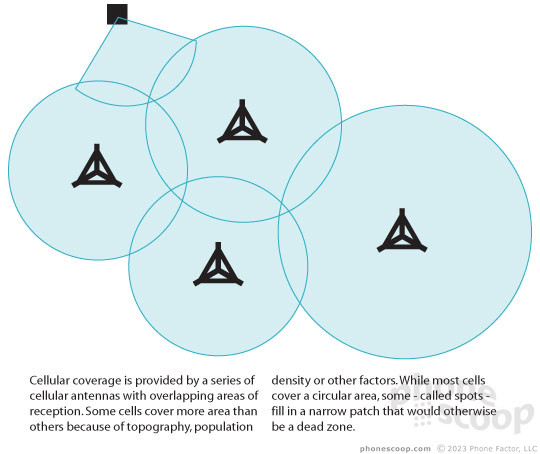
How A Call Is Made
No matter where you are, if your phone displays a network name (as opposed to "no service" or a similar message) it is wirelessly connected or attached to a cell. When you come in range of a cell, it sends a message to the network, which then knows you're available and where to direct your calls.
When someone dials your number, a signal is sent out to the switching center responsible for your phone number. This switching center then looks to see if your phone is currently attached to a cell. If you are in range of a cell, a signal is sent to your phone to set up the call, and that's when your phone rings. This setup signal contains the caller ID and other vital information.
When you choose to answer the call, the cell sets aside a slice of capacity for your conversation, called a circuit. If the cell has already reached its capacity, the call will not go through and will typically be sent to your carrier's answering service, or voicemail.
If you begin moving out of range of a cell while on a phone call, the call will be passed on to a new cell if one is available. This process, called a handoff, is negotiated between your phone, the two cells, and the command center behind the scenes while you are on the call. However if there is no cell in the direction you are moving, or the cell has reached its capacity, the call is unexpectedly ended, or dropped.
Pressing the end key closes the circuit that you were assigned and tells the switching center you have ended the call.
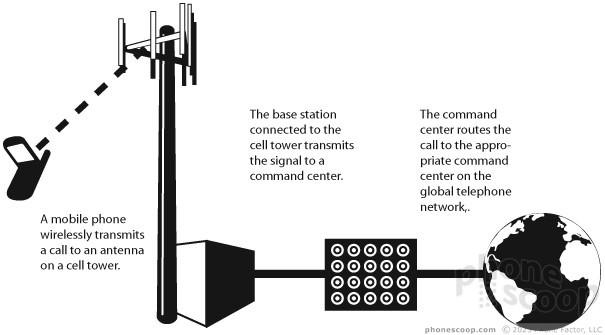
Making a call works in pretty much the same fashion. When you enter a number to call, there is no dial tone because your phone is not connected to the cell yet. Your phone initiates a circuit with the cell by transmitting the desired phone number to call once you press the send key.
Details
Now It Begins
Once you understand how a cellular network - and the process of a phone call - work, the answers to the most common questions about cellular technology are easier to answer. The majority of questions new users tend to ask focus on the radio frequency or spectrum aspect of the cellular networks, which we will clarify now that we've explained how terms like cell, base station, circuit and others fit in to the network picture.
Spectrum
Governments the world over define ranges of radio frequency to be used for specific uses. Those uses range from radio broadcasts (FM and others) to television transmission to cellular communications and even ranges called unlicensed spectrum which provide a band for cordless phones, Wi-Fi, and Bluetooth to work in.
Many countries cooperate to make sure that the range of radio spectrum they license for a particular use is the same as other countries, at least nearby countries. For instance FM radio uses the rage from 88 to 108 MHz nearly the world over. These ranges are defined in Hertz (Hz), which is one of the measurements used for radio waves. Cell phones, FM Radio and other new technologies often use very small radio waves, which are measured in Megahertz (MHz).
Europe worked together to assign radio spectrum for cellular phones as well and since they are such a large force in the cellular world, most of the Middle East, Africa and Asia has chosen to use the same bands. European phone use the 900 and 1800 MHz bands for their older GSM networks, and the 2100 MHz bands for their new 3G networks. GSM and 3G will be explained later in this article.
Because the US had already assigned the 900 and 1800 MHz bands to other uses, they broke with the European standards. First, they licensed the 850 MHz range for cellular phones, which is why this is often referred to as the Cellular band in the US. It is also called the 800 MHz band. They later added the 1900 MHz band, which is often called the PCS band. Instead of 850 and 1900 MHz, Nextel operates in some separate spectrum near the 850 Mhz band.
Canada and Mexico both follow the US's lead for radio licensing as does much of Latin and South America. Most of their cellular networks also operate on 850 or 1900 MHz as well. Although the US has defined a specific spectrum range for 3G, it has not been auctioned off yet. Instead of waiting for an auction, carriers with enough spectrum are launching advanced networks on the two existing bands.
Bands + Modes
Most national and even regional carriers in the US use more than one band; they have purchased the rights to spectrum in both the 850 and 1900 MHz range. Sometimes they use 850 in one area and 1900 in another. Sometimes they use both bands in the same area. In fact if you change cells during a phone call, you might even start the call on one band and end on the other.
When the FCC licenses a band of spectrum, they subdivides it into a number of blocks of varying sizes and auction them off. However winning this auction does not entitle a carrier to that block of spectrum nationwide, instead this process is repeated for every geographic area. A larger carrier may not win an auction for a single block large enough to meet its needs in some area. In this case the carrier may try to acquire additional blocks on the other band if they cannot purchase more space on the same band.
Some carriers, like T-Mobile, have been able to only use only one band (1900 MHz in their case) and will share spectrum with other carriers rather than resort to purchasing spectrum on the other band. However many of the phones T-Mobile sells work on additional bands, often including support for 850 MHz or European bands.
Tower of Babel
Other than phones like Nextel's, most phones sold in the US have both 850 and 1900 MHz radios. So if they all receive the same bands then why can't you use any phone with any carrier?
That answer is that they often speak different languages. The phones use different languages to talk to the cell towers. Or, sometimes phones use the same language to talk to the cell tower, but use different programming languages to run games and other applications.
The different languages used for communication between the phones and cell towers are called protocols. Currently, US carriers concentrate on two different protocols. Sprint, Verizon and many smaller carriers use CDMA - a protocol developed by Qualcomm, and used primarily for newer cell phone networks in the Americas and East Asia (Korea, Japan, etc). Cingular and T-Mobile use GSM - which began in Europe and is the most popular protocol worldwide.
There are a few more protocols that are still in use in the United States. Nextel uses iDEN, a protocol developed by Motorola, but will be phasing this out. Some carriers still offer AMPS (analog) and TDMA, however they are both relatively obsolete, especially now that 3G systems are launching throughout the US and are being phased out as well.
Although they both use the same CDMA protocol, Sprint and Verizon use two different programming languages for the applications you can download. Manufacturers will build two models of the same phone but install different decoders for programming languages on them. These two different languages are called Java, which Sprint uses, and BREW, which is Verizon's choice. GSM carriers as well as Nextel also use Java for their programming language.
Brief History
3G? What About 1 and 2?
3G stands for 3rd generation; it is the next revision of cellular protocols.
The first generation was analog protocols. One called AMPS was the primary one used in the US and is the only one still in use here. Analog systems are relatively inefficient and don't sound very clear, but there are many rural areas which still have not been upgraded to a more modern system.
Second Generation (2G) protocols are digital. They use less power and tend to have clearer sound. Digital systems allow many more callers to use a cell at one time because they can divide up the limited spectrum of a cell more efficiently. TDMA, GSM, and CDMA are all 2G technologies. When 2G technologies were being developed, voice calls were their focus.
As ringtones, mobile web browsers and picture messaging were under development, the players in the cellular industry realized they had done a good job improving voice calls, but the data services these new applications required were still in the '80s. They developed protocols that came to be known as 2.5G. New, faster data transmissions protocols were developed. For GSM systems, this is called GPRS, for CDMA it is called 1xRTT. TDMA was dropped by many carriers, which then shifted to GSM, because there were no significant 2.5G TDMA developments.
The upgrade to 1xRTT was much more significant than the upgrade to GPRS. In addition to significantly speeding up data, CDMA 2000 1xRTT also doubled the voice capacity of the original CDMA protocols.
Not much more could be done to improve the way voice calls work, but 2.5G data speeds were still pretty slow, which is why industry players have been launching 3G networks. Where 2.5G was built on 2G technologies, 3G is built on newer technologies that requires new phones and new base stations, so it takes some time to launch.
Fine, So What About 3G?
CDMA networks like Verizon, Sprint and Alltel are launching a 3G technology called EV-DO (EVolution, Data Only). They will follow this up with further advancements in speed based on the same technology, such as EV-DO Revision A. EV-DO networks use a different data protocol, but they still use the same voice technology as 1xRTT networks.
GSM networks call 3G by two different names: WCDMA (Wideband CDMA), which is the name of the protocol, and UMTS. The first version of this technology has been launched in much of Europe, Asia and the Middle East. The second version, HSDPA, is the version that Cingular intends to launch, and it improves download speeds significantly. Even faster revisions are also being developed; they include HSUPA and a "super 3G" called UTRAN LTE.
The goal of all these advances in data is to speed up the data rate, and decrease the lag time between sending the data and it arriving at its destination, called latency. As these two factors are improved, new applications such as streaming video, video calls and more are possible. Carriers are also selling subscriptions on these fast networks to laptop users who want broadband-like data speeds without being tied to cables or even Wi-Fi access points.
Because 3G does not exist everywhere there is cellular coverage, manufacturers are building 3G phones that are compatible with older 2G and 2.5G networks. It will be a long time before any major carrier can launch 3G service over their entire coverage area, and even longer before every subscriber on that carrier switches to a 3G handset. Thus 2G networks and handsets that are backwards compatible will be around for quite some time.
Keep It Going
We could go on for hours just on spectrum alone, and in the future we will. However this primer should have answered at least most of your questions about cell phone networks. If there's something you still don't understand, or something else you'd like to know please tell us.
Because this primer is here to help you, not just inform you, we want your feedback. Click the next tab labeled "Discuss," and tell us if there's something we need to clarify or explain further. We'll take a look and if we agree, we'll revise this primer. Your feedback can help us help more people. We've been working in the wireless world for so long that it's honestly hard to us to know if we've done a good job explaining this without your feedback.
We have plans for additional primers, so it's possible we may not address your question here if we know it will be covered in another installment. But we'll let you know, and address your request in the discussion, in further revisions to this primer or in future primer installments.
Comments
Happy to Help
(continues)
Put this on the main website!!!
FINE, fine piece of work, that Primer to Cellular Networks. PUT IT ON THE MAIN SITE, off to the left, with the other links! Man, this is the kind of stuff that I DON'T want to have to go hunting around for--dude, I'm BACK to dial-up, because I can't afford DSL--when I'm surfing.
I found the site via Jim Karpen's Web Guide at PocketPC Magazine http://www.pocketpcmag.com/newsl_JKWG/webguid e.asp?id=273, and I was elated. This is the kind of stuff I need: short, concise and to the point. You did it well here, Eric. Thank you very much...BUT PUT IT ON THE MAIN SITE!!!
Hey, thanks again,
Starkman
Come on, guys. Keep it consistent, and put this link on the left-hand...
(continues)
you asked...
the second is that we are bumping our spectrum primer (we're still doing it, but just not first) in favor of a more thorough explanation of gsm and cdma - how each works, what each is capable of, where each is heading in the foreseeable future and where each is available.
this comparison should answer many of your requests and questions, which is why we haven't really been answering them here.
Digging Deeper
Great overview. I'd like to dig deeper into spectrum use technologies (protocols, compression schemes, etc.) What are some references (books, sites) that you find useful?
Thanks.
Doug
Excellent, Educational, Easy to Understand Article by Eric Lin
Now my question, which has practical consequences regarding our choice of cell phone to buy:
I understand that upgrading GSM (Cingular and T-Mobile) will be more costly than upgrading CDMA/SPC (Verizon and Sprint).
If that is true, it stands to reason that the CDMA upgrade will progress faster than the GSM upgrades.
The ultimate projection is that CDMA > EV-DO > EVDO Revision will be more widespread than GSM > WCDMA/UMTS > HSUPA & UTRAN LTE and will happen at a faster rate, because it will cost Verizon and Sprint less to implement. More Verizon and Sprint people will be enjoying their "bigger/faster" soone...
(continues)
lorna said:
BTW, whoever decided to call it WCDMA should have realized that it would be perceived by laymen as a CDMA rather than a GSM upgrade. I think that they should have used only UMTS, which doesn't mislead.
...
(continues)
Discuss Different Technologies
we also considered adding further depth to how each t...
(continues)
Taking the time
(continues)
Excellent article - thanks for taking the time to do this...
Again - this was a superb intro and anything else is gravy and very much appreciated.
Thx as well for maintaining this whole site - even though I'm not involved in the industry per se', I have an active interest in technology and manage all the cellular devices for our company and this site is one of my main sources of information - it's a huge help.
very informative article
p.s first post, alright!!


 iPhone 14 Plus Offers a Big Screen For Less
iPhone 14 Plus Offers a Big Screen For Less
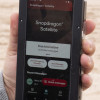 Qualcomm Taps Iridium for Satellite Connectivity
Qualcomm Taps Iridium for Satellite Connectivity
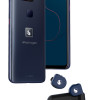 New Asus Phone for Snapdragon Fans Showcases Qualcomm Tech
New Asus Phone for Snapdragon Fans Showcases Qualcomm Tech
 Google Pixel 5a Sports Large Battery, Water Resistance
Google Pixel 5a Sports Large Battery, Water Resistance
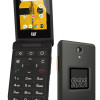 CAT Puts Android With Play Store in a Compact Flip Design
CAT Puts Android With Play Store in a Compact Flip Design

